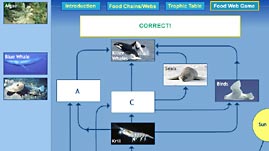Teachers' Domain - Digital Media for the Classroom and Professional Development
User: Preview

Source: Bigelow Laboratory for Ocean Sciences
This interactive game adapted from the Bigelow Laboratory for Ocean Sciences challenges players to build a food web, a complex model that shows how various food chains in an ecosystem are connected. Players must position the names of producers and consumers in the correct places in a diagram. The completed diagram reveals how energy flows through an Antarctic ecosystem and the relationships between predators and prey.
Ecosystems are composed of living things and the physical environment with which they interact. Different species within an ecosystem have different functions that help cycle energy from the Sun—the source of nearly all energy that is critical to life on Earth—through it. Some species are producers, which convert sunlight into chemical energy through photosynthesis. Others are consumers, which feed on producers (and other consumers). These species can be further organized into groups or levels called trophic levels. Organisms at higher trophic levels feed on those at lower levels. For example, in a marsh ecosystem, grasses produce food directly from sunlight, grasshoppers feed on marsh grasses, and shrews eat grasshoppers.
Simple models called food chains depict one possible path along which energy moves through an ecosystem—as from producer A to consumer B to consumer C. Most consumers have more than one food source, however. Therefore, a more complex model called a food web is used to show how the various food chains in an ecosystem are connected. In the Antarctic ecosystem, both algae and small, shrimp-like crustaceans called krill are connected by arrows to fish, which consume them. Because krill are also consumed by birds and blue whales, arrows connect to each of those animals as well as to fish. In all cases, arrows point in the direction in which energy moves to the consumer. Because killer whales eat blue whales, fish, birds, and seals, and because killer whales have no natural predators in the Antarctic ecosystem, killer whales are said to be the Antarctic food web's top predator.
Two other essential members of the food web are decomposers and scavengers. These are an ecosystem's primary recyclers, which feed on dead plant and animal life, breaking down organic waste material and returning essential elements, including nitrogen and phosphorous, to the ecosystem.
Organisms within an ecosystem rely on others as food sources, so any disturbance in population can have broad and lasting effects. For example, in the Antarctic food web, if krill were to vanish from Antarctic waters, blue and other baleen whales would follow. These species feed exclusively on krill. Penguins and seals feed on krill in part, but also on other animals that depend exclusively on krill, so they would be affected as well. Without krill, other primary consumers, including zooplankton, would be consumed in greater volume. With too much competition and not enough food, many different animals would ultimately disappear.
 Loading Standards
Loading Standards Teachers' Domain is proud to be a Pathways portal to the National Science Digital Library.
Teachers' Domain is proud to be a Pathways portal to the National Science Digital Library.
